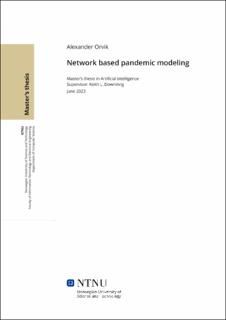| dc.contributor.advisor | Downing, Keith | |
| dc.contributor.author | Orvik, Alexander | |
| dc.date.accessioned | 2023-09-01T17:20:08Z | |
| dc.date.available | 2023-09-01T17:20:08Z | |
| dc.date.issued | 2023 | |
| dc.identifier | no.ntnu:inspera:145904930:11759958 | |
| dc.identifier.uri | https://hdl.handle.net/11250/3087140 | |
| dc.description.abstract | Beregningsbasert epidemiologi er et stort felt med mange tilnærminger og verktøy for modellering av pandemier. Disse tilnærmingene varierer fra statistisk analyse og differensialligninger, agentbasert modellering og til og med hybridmetoder som kombinerer de ovennevnte. Denne avhandlingen sikter mot å utvide verktøykassen med et nytt verktøysett som integrerer grafteori og agentbaserte metoder. Dette gjør at man kan utforske et bredt spekter av innstillinger og miljøer som endrer innvirkningen og utviklingen av patogen aktivitet i en gitt befolkning. Avhengig av det gitte miljøet, vil patogenet forsøke å optimalisere seg selv basert på ytelsesfunksjonsvekter som blir gitt som en input til systemet gjennom bruk av en variasjon av den genetiske algoritmen. Systemets fleksible natur gir opphav til mange forskjellige scenarier som kan testes. Systemvariablene varierer fra befolkningens sosiale struktur gjennom forskjellige nettverkstopologier, simulerte immunrespons med statiske og dynamiske befolkninger, sykdomsisolasjonspolitikk og mer. | |
| dc.description.abstract | Computational epidemiology is a large field with many approaches and toolkits for modeling
pandemics. These approaches ranges from statistical analysis and differential equations, agent-
based modeling and even hybrid methods combining the aforementioned ones.
This thesis aims to expand the toolkit with a novel toolset that integrates graph theory and
agent-based methods. This allows one to explore a wide range of settings and environments that
changes the impact and development of pathogen activity in a given population. Depending
on the environment provided, the pathogen will attempt to optimize itself based performance
function weights provided as an input to the system through the use of a variation of the genetic
algorithm. The flexible nature of the system gives rise to numerous different scenarios that can be tested.
The system variables range from the social structure of the population through different network
topologies, simulated immune responses with static and dynamic populations, sickness isolation
policy and more. | |
| dc.language | eng | |
| dc.publisher | NTNU | |
| dc.title | Network based pandemic modeling | |
| dc.type | Master thesis | |
